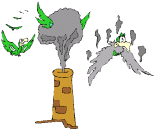
Wildlife
 There are three ways in which animals can be affected by air pollution. They can breathe in gases or small particles, eat particles in food or water or absorb gases through the skin. Mainly soft-bodied invertebrates, such as earthworms, or animals with thin, moist skin, are affected by absorbing pollution.
There are three ways in which animals can be affected by air pollution. They can breathe in gases or small particles, eat particles in food or water or absorb gases through the skin. Mainly soft-bodied invertebrates, such as earthworms, or animals with thin, moist skin, are affected by absorbing pollution.
Some gases from pollution mix and react together in the air to form new pollutants. Ozone is one such secondary pollutant. Ozone is naturally found high in the atmosphere, and protects all living things by filtering out some of the Sun's harmful rays. When it is formed near the ground, largely as a result of traffic pollution, it can be harmful to plants and animals. Ozone, as well as the air pollutants sulphur dioxide and nitrogen oxides, can affect the breathing of animals.
Particulates, given off by diesel-powered cars, buses and lorries, can cause many problems for wildlife. When the particulates contain metal they are especially dangerous, as high levels can build up in the body tissues of animals.
As well as these direct effects of pollution, wildlife is also affected by changes in the environment caused by pollution and acid rain. A change in the acidity of the water that animals live in, or a decrease in the amount of trees that provide shelter, may cause serious problems for wildlife.
Websites
Other topics Technical Page
Technical Page
• US Wildlife Federation
• Introduction
• Cars
• Doing Our Bit
• Human Health
• Impacts
• Indoors
• Industry & Power
• London Smog
• Outdoors
• Pollutants
• Smog
• Wildlife
 Print Topic
Print Topic